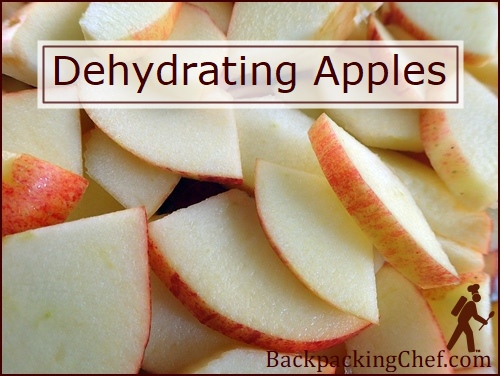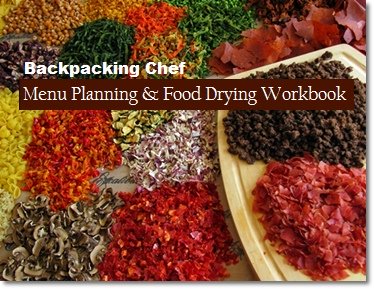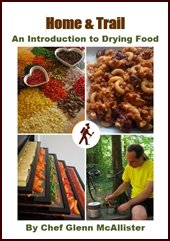Dehydrating Apples: Seven Fun Projects for Apple Lovers
Are you ready to have some fun dehydrating apples?
Slicing and drying apples is just the beginning, which I cover in the first project with instructions for pretreating apples and storage options.
Dehydrated apple slices are great in oatmeal and trail mixes, and I love to rehydrate apples on the trail with cold water for refreshing afternoon fruit cocktails.
The next five apple-drying projects cover how to dehydrate apples that are:
- Grated.
- Baked in the oven with pumpkin spices.
- Cooked on the stovetop with apricots.
- Blended into applesauce for fruit leather.
- Combined with granola to make apple-granola clusters.
You're going to have a lot of fun making, and then eating, Tortilla Apple Tarts, Bircher Muesli, Pumpkin Spice Apples, Applesauce, and Apple-Granola Clusters.
Table of Contents
Do you need to pretreat apples before dehydrating?
Lemon juice, ascorbic acid, and blanching. Which method works best to prevent browning?
Dehydrating Apple Slices
For snacking on dry or rehydrating with hot or cold water. Perfect for an afternoon fruit cocktail.
Storing Dehydrated Apples
Short-term and long-term storage methods for dried apples.
Dehydrating Grated Apples
Wonderful as a dried snack with a hint of lemon, and also great in Hot Tortilla Apple Tarts and No-cook Bircher Muesli.
Dehydrating Baked Apples
Truly amazing… Cinnamon Spice Apples baked and dehydrated. A delicious trail dessert served hot, or try it at home a la Mode with ice cream.
Dehydrating Cooked Apples
Apples cooked on the stove, alone or in combination with apricots, creates extra juice and sweetness. Perfect with Backpacker Pancakes.
Dehydrating Applesauce
Tear applesauce leather into pieces for snacking, or rehydrate it back into applesauce with hot or cold water.
Pumpkin Spice Apple Fruit Leather
Cinnamon, ginger, nutmeg, and ground cloves, with a hint of orange, make this a delicious apple fruit leather that can be reconstituted into applesauce.
Dehydrating Apple-Granola Clusters
Applesauce combined with homemade granola and dried into apple-granola clusters in a dehydrator. Delicious!
Ask Chef Glenn FAQ about dehydrating apples.
Do you need to pretreat apples before dehydrating?
Pretreating apples for dehydration is optional, but pretreatment by blanching or dipping cut apples in an acidic solution of water and either lemon juice or ascorbic acid, will prevent oxidative browning.
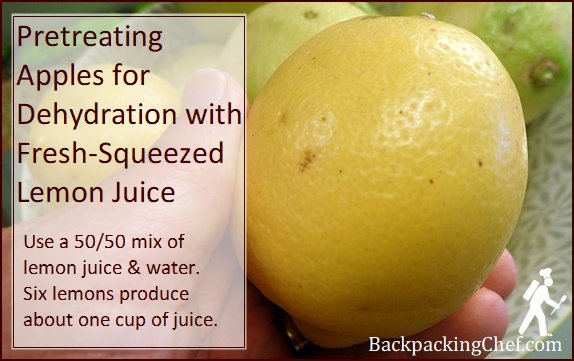
The choice of pretreatment method used will affect the taste of the dried apples, by either imparting a tart flavor to the apples, or in the case of blanching, a reduction of sweetness.
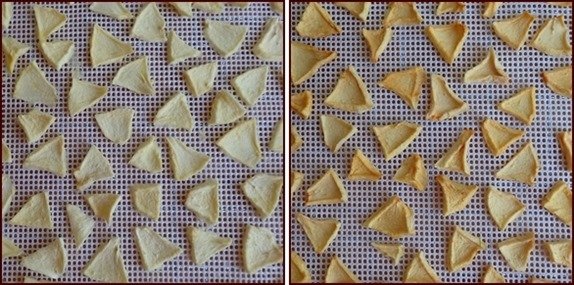
Photos: Dehydrated Gala Apples, pretreated with lemon juice solution on left, no pretreatment on right.
The following article demonstrates, by way of experiments, each of the apple pretreatment methods, and evaluates the impact of each method on color retention and taste of the dehydrated apples.
Explore More…
How to Pretreat Apples for Dehydrating.
Dehydrating Apple Slices
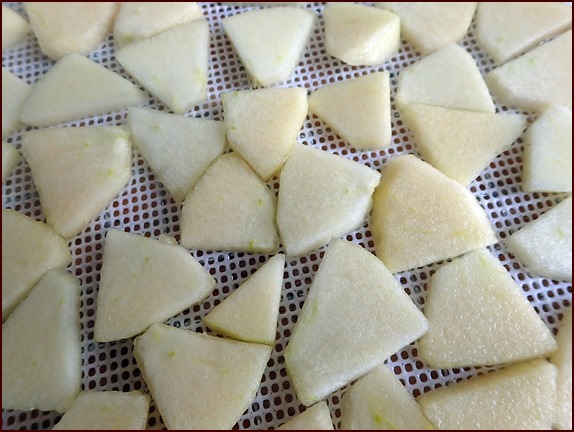
Photo: Dehydrating apples cut into slices on a silicone mesh dehydrator sheet.
Steps:
- Peeling is optional. Leaving the skins on is more nutritious, but the dried apples will be a little chewier. If leaving skins on, wash apples to remove dirt and pesticides.
- Cut apples into quarters and remove cores. Slice the quarters crosswise into ⅛-inch to ¼-inch thick pieces.
- Spread in single layer on dehydrator trays and dehydrate at 135°F (57°C) for eight to twelve hours.
Dried apples will be pliable and dry to the touch. When you tear a piece in half, no moisture will be visible. After apples cool, store in an airtight container.
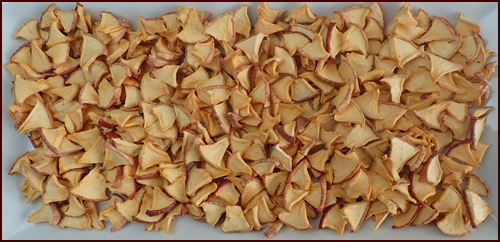
Photo: Dried apple slices, which were not pretreated, after storage in an airtight jar for six months. Shows minimal browning from oxidation.
Rehydrating Dehydrated Apples
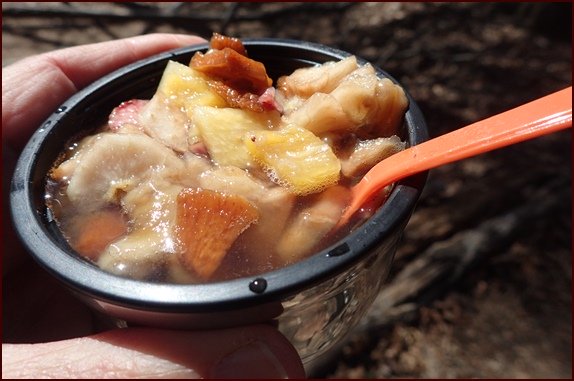
Photo: Dehydrated apples, pears, bananas, and pineapples rehydrated for an afternoon fruit cocktail in a thermos food jar.
Fill the thermos food jar with one cup of assorted dried fruits and two cups of cold, filtered water. Late afternoon, when an energy boost is needed for the last miles of the day, take a fruit cocktail break. The fruit is well-rehydrated by then, and a cup of sweet fruit juice remains. This is super refreshing in the summer.
Shop Amazon: Thermos Food Jar.
Storing Dehydrated Apples
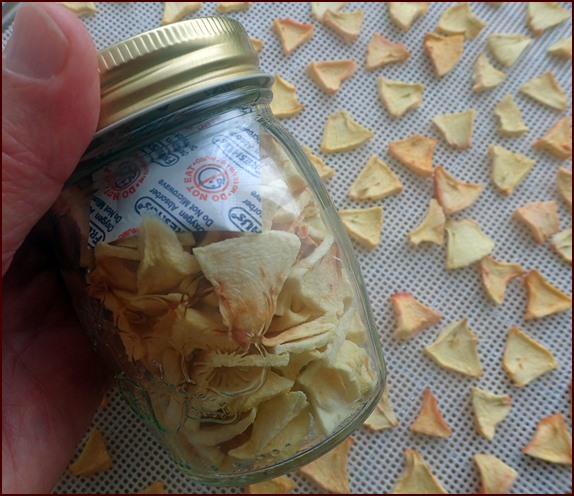
Photo: Dried apples stored in an airtight jar with an oxygen absorber. The apples were dried without pretreatment, so there was some darkening during dehydration, but the oxygen absorber will prevent further oxidative browning in storage.
Conditioning: After dried apples have cooled, place them loosely in a jar with the lid on. Observe apples over a few days and shake the jar once a day. If any moisture appears on the inside of the jar, put the apples back in the dehydrator to finish drying.
Short-term Storage: Dehydrated apples will keep well for several months if stored in Ziploc bags away from heat and light.
Long-term Storage: Dehydrated apples will remain in excellent condition for a year or more if stored in an airtight container.
Storage Methods:
- Mason jars with oxygen absorbers.
- Mylar bags with oxygen absorbers.
- Mason Jars sealed with vacuum-sealing attachment.
- Vacuum sealed in vacuum-seal bags.
Dehydrating Grated Apples
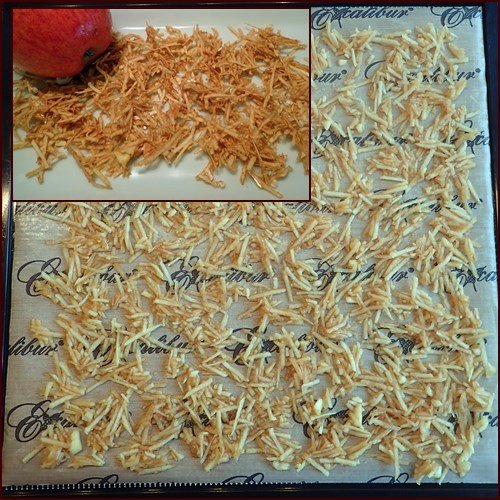
Photo: Grated apples spread loosely on Excalibur dehydrator tray covered with nonstick sheet. Inset: Grated apples dried.
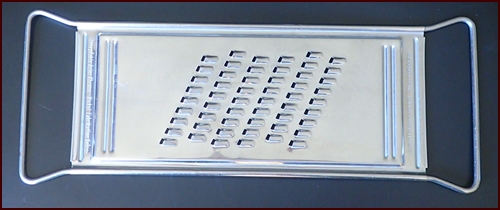
Photo: Grater used to grate apples coarsely.
Steps:
- Peel and core apples, then grate them coarsely into a bowl of fresh-squeezed lemon juice. Stir as you go. Use one lemon per five apples grated. Lemon juice imparts a harmonious citrus taste to the apples. Although lemon juice keeps apple slices from turning brown, it is less effective for preventing browning with grated apples, due to the amount of cells exposed to oxygen caused by the grating.
- Spread grated apples and all juices on dehydrator trays covered with nonstick sheets. An Excalibur dehydrator tray will hold two to three grated apples.
- Dehydrate at 135°F (57°C) for 10 to 14 hours.
Dried grated apples are wonderful for trail snacking. They juice up in your mouth faster than dehydrated apple slices, and the lemon treatment imparts a nice citrus flavor.
They can also be heated and rehydrated to make trail tarts, or soaked overnight with oats and berries to make Bircher Muesli.
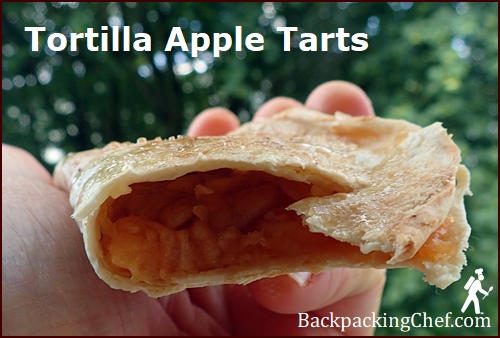
Photo: Tortilla Apple Tart made by folding hot, rehydrated grated apples and walnuts into a tortilla. Excellent with cinnamon and sugar sprinkled on top, and lightly heated in foil.
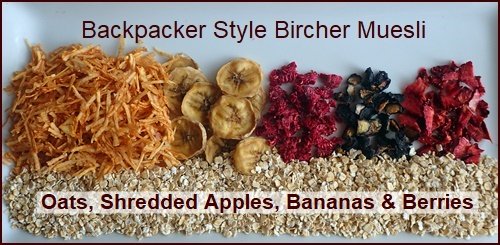
Photo: Bircher Muesli, a no-cook breakfast which includes grated apples, berries, nuts, and oats. Rehydrated overnight, it’s ready to eat in the morning.

These dehydrated apple recipes are featured in previous newsletters and can be found here:
Subscribe to Trail Bytes, my free monthly newsletter, and get a free e-book, Home & Trail: An Introduction to Drying Food.
Dehydrating Baked Apples
You’re going to love this baked apple dehydration project!
Heat up baked pumpkin spice apples on the trail with boiled water, or serve them a la Mode with ice cream at home.
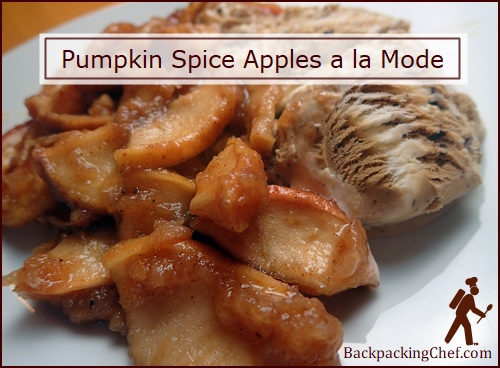
Photo: Hot Pumpkin Spice Apples a la Mode served at home. Makes a delicious trail dessert, too. Highly recommended!
Pumpkin Spice Apples
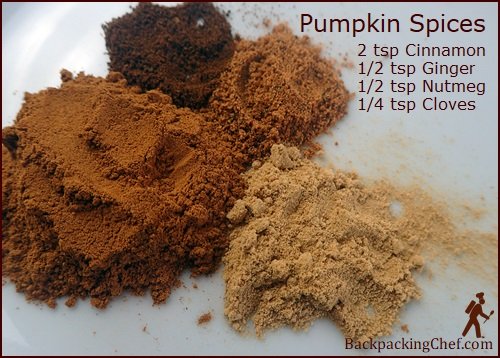
Ingredients:
- 4–5 lbs. apples (1814 – 2268 grams)
- ¼ cup fresh lemon juice
- 2 Tbsp. raw sugar, divided
- 2 tsp. ground cinnamon
- ½ tsp. ground ginger
- ½ tsp. ground nutmeg
- ¼ tsp. ground cloves
Yield: 8 servings of ½ cup (25 grams) each.
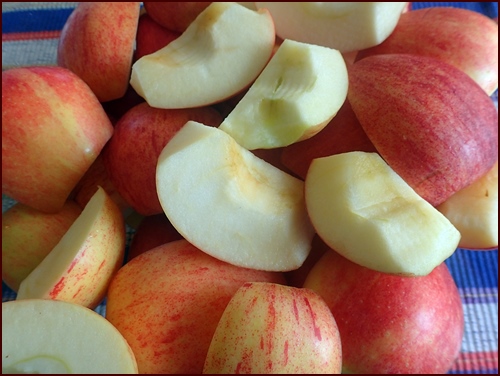
Photo: Gala apples quartered with cores removed. Skins left on.
For this project, begin with four pounds (1814 grams) of apples. If you have a very large baking dish, you could start with five pounds (2268 grams).
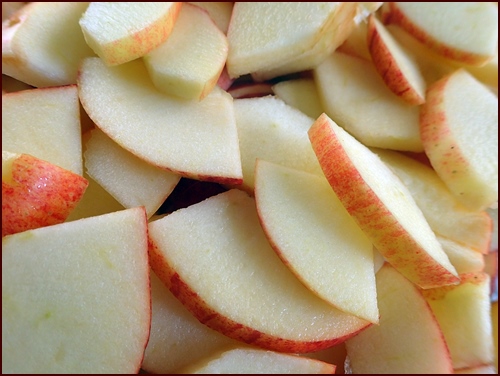
Photo: Thickly sliced apples, ready for lemon juice, sugar, and pumpkin spices.
Prepare the Apples for Baking:
- Cut apples into quarters and remove cores. Then, slice quartered apples crosswise about ¼-inch thick. This is a little thicker than when drying uncooked apples. The extra thickness keeps the apples from getting mushy in the oven. Leaving the skins on also helps keep the apples intact as they cook.
- Combine ground pumpkin spices: 2 tsp. cinnamon, ½-tsp. ginger, ½-tsp. nutmeg, ¼-tsp. cloves, and 1 Tbsp. raw sugar.
- Place apples in deep baking dish and stir in the grated peel of one large or two small lemons, plus the lemon juice. Desired quantity is a quarter-cup of fresh lemon juice.
- Fully coat apples with pumpkin spices and sugar.
- Cover baking dish with foil. Bake apples in preheated oven at 350°F (180°C) for one hour. At 30 minutes, stir apples to exchange the bottom apples with the top apples.
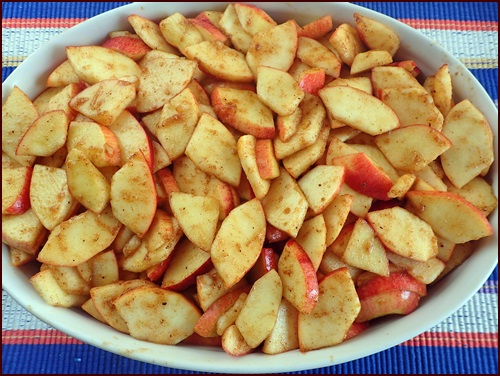
Photo: Pumpkin spiced apples, ready for the oven.
Dehydrate the Baked Apples & Applesauce

Photo: Baked cinnamon spice apples on dehydrator tray.
As soon as the baked apples are cool enough to handle, place the slices in single layers, directly on mesh sheets of dehydrator trays.
Make One Cup of Applesauce
While placing apple slices on the dehydrator trays, put any small or mushy pieces in a separate bowl. You want to set aside enough soft apples and juices to make one tray of apple leather.

Photo: Hand mashing the soft apple pieces and juices.
Hand mash all juices, soft pieces, and one tablespoon of raw sugar, so that you end up with one cup of sweetened pumpkin spice applesauce.
Spread applesauce thinly on dehydrator tray covered with nonstick sheet.

Photo: Hand-mashed applesauce on Excalibur dehydrator tray covered with nonstick sheet.
Begin dehydrating apples and applesauce at 145°F (63°C) for the first two hours, then reduce temperature to 135°F (57°C) for the remaining time.
Total estimated drying time is 10 to 12 hours.
If you start with four pounds of apples, the slices will take up three Excalibur dehydrator trays, and the mashed apple slurry will take up one tray. With five pounds of apples, five trays could be utilized, but you would have to start with a larger baking dish.

Photo: Dehydrated pumpkin spiced apples.
Storage
Store dehydrated apple slices and applesauce leather in separate airtight containers. Allow dried apples to cool before placing in storage container, or condensation may form inside the container.

Photo: To keep dried applesauce leather from sticking to itself in storage, fold it up in baking paper.
Rehydrating Pumpkin Spice Apples
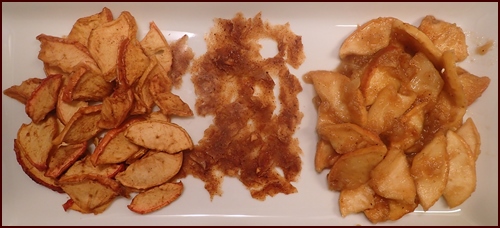
Photo: (L) ½-cup (25 g) dried apple slices, (M) pieces of dried apple leather (7 g), (R) rehydrated with ½-cup (118 ml) hot water.
On the Trail:
Place ½-cup (25 g) of dried apple pieces, plus a few torn pieces of applesauce leather (7 g) in a pot with ½ cup water. Heat to desired temperature, allowing at least 20 minutes for apples to rehydrate. You can also rehydrate by adding boiled water to the ingredients in a thermos food jar.
At Home Serving Suggestion:
Heat and rehydrate apples and leather pieces as describe above, and serve a la Mode with ice cream.
Dehydrating Cooked Apples
Precooking apples on the stove enables you to combine the apples with other fruits, like apricots, while creating sweet juices. Dried cooked apples are delicious for snacking, and they rehydrate well with hot or cold water.
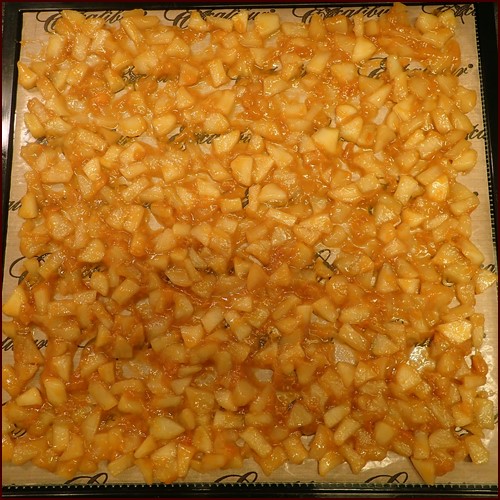
Photo: Dehydrating cooked apples and apricots on Excalibur dehydrator tray covered with nonstick sheet.
Ingredients:
- 6 apples
- 6 apricots
- ½ large lemon, juice and grated peel
Steps:
- Peel and cut apples and other fruits into pieces. If desired, leave the skins on.
- Place cut fruit, grated lemon peel, and lemon juice in a pot. Bring to a boil, and then reduce heat to low. Cook for 10 minutes.
- After fruit cools, spread on dehydrator trays covered with nonstick sheets.
- Begin dehydrating apples and apricots at 145°F (63°C) for the first two hours, then reduce temperature to 135°F (57°C) for the remaining time.
Total estimated drying time is 12 to 15 hours. Drying time may be shortened by not overloading the trays.
Store dehydrated apples and apricots in an airtight container. Cool before placing in storage container.
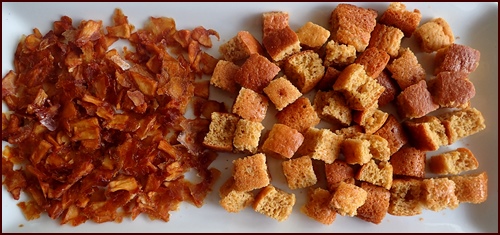
Photo: A serving of backpacker pancakes with dried apples and apricots, before rehydrating.
Get the recipe for Backpacker Pancakes in this back issue of Trail Bytes: Backpacker Pancakes.
Dehydrating Applesauce
Dried applesauce can be enjoyed as a snack (applesauce leather) or can be rehydrated back into applesauce with hot or cold water.
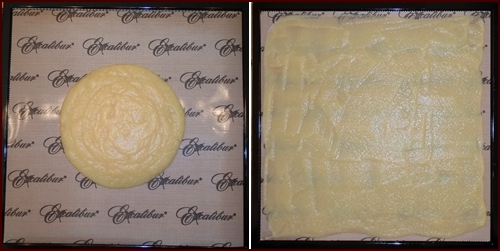
Photo: One cup of applesauce spread thinly on Excalibur dehydrator tray covered with nonstick sheet.
Ingredients:
- 8 medium apples, peeled and cored
- 1 cup apple juice
- ⅛ tsp. cinnamon
- Pinch of salt
Yield: Eight apples yield approximately two cups of applesauce leather.
Steps:
- Cut apples into small pieces and place in pot with apple juice, salt and cinnamon. Bring to a boil and then reduce to low temperature. Cover pot and simmer for 20 minutes. Allow mixture to cool.
- Run cooled apple mixture through a blender and blend until smooth. Eight small to medium apples will produce approximately 32 ounces of applesauce before drying.
- Spread applesauce thinly, about ⅛ inch thick, on nonstick sheets. One cup of applesauce is a good amount to dry on one Excalibur dehydrator tray.
- Dehydrate applesauce at 135°F (57°C) for eight to twelve hours depending on the juiciness of the mixture. After about six hours, peel applesauce leather off the nonstick sheets and place directly on the mesh trays to expose the bottom to more air circulation.
- Applesauce leather dries pliable, not brittle. Dry it thoroughly so that it is not sticky on the surface or still holding moisture in any thicker parts. To keep applesauce leather from sticking to itself in storage, fold it up in baking paper.
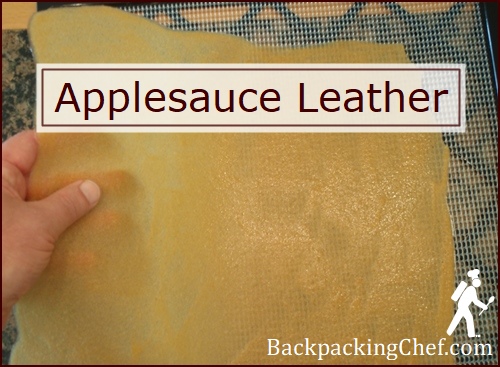
Reconstituting Dehydrated Applesauce
Combine applesauce leather with an equal quantity of water.
For one serving, combine ¾-cup each of water and leather (40 grams leather). Hungry hikers will have no problem eating a full cup of applesauce leather rehydrated with one cup of water. Trust me, I know.
If serving cold, soak in cold water for ten to fifteen minutes and stir vigorously.
For a hot treat, combine with hot water. Applesauce leather will reconstitute faster in hot water, about five to ten minutes.
Pumpkin Spice Apple Fruit Leather
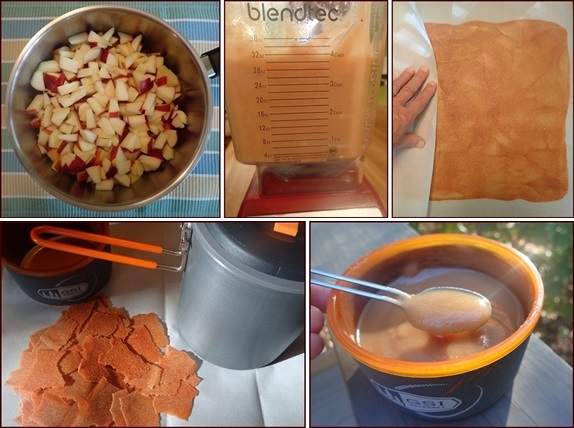
This dehydrated pumpkin spice apple fruit leather is so good it gets its own page. The warm pumpkin spices of cinnamon, ginger, nutmeg, ground cloves are perfectly balanced with the zest and juice of one orange. Enjoy it as leather or reconstitute it into applesauce.
Explore: Pumpkin Spice Apple Fruit Leather Recipe.
Dehydrating Apple-Granola Clusters
Apple-Granola Clusters are amazingly delicious, nutritious, and easy-to-make.
All you have to do is combine applesauce with homemade granola, and dry it in a dehydrator.
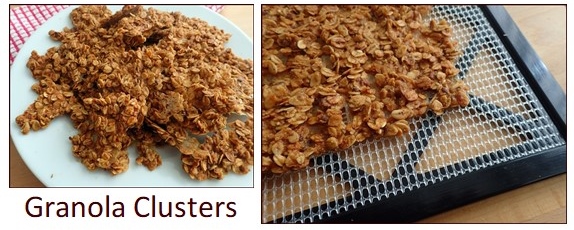
Photo: Apple-Granola Clusters dried in a dehydrator. Delicious!
How to Make Apple-Granola Clusters
- Blend diced apples into applesauce.
- Combine with homemade granola.
- Dehydrate at 135°F (57°C) for approx. 11 hours.
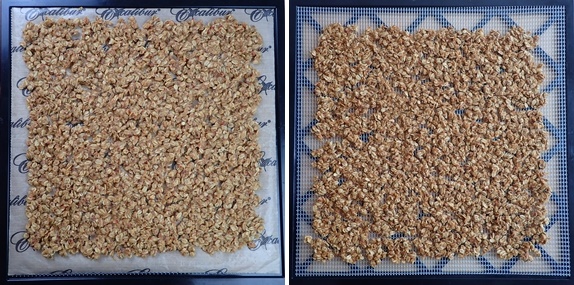
Explore More…
Get the complete instructions for making apple-granola clusters on the granola page, which includes my healthy granola recipe, plus more granola cluster recipes with bananas, pineapples, and oranges.
How to Make Apple-Granola Clusters.
FAQ About Dehydrating Apples

Ask Chef Glenn
If you have a question after reading this page, send it to me, and I’ll get back to you with an answer.
What
are the best apples for dehydrating?
What
are the best apples for dehydrating?
Gala and Honeycrisp apples are good for sweetness.
Granny Smith and Kanzi apples are good for tart flavor.
Pink Lady apples offer a good balance of sweet and tart.
How
long do apples take to dehydrate?
How
long do apples take to dehydrate?
If you slice the apples thinly, about ⅛-inch thick, they may be dry in as little as eight hours at 135°F (57°C). Drying time will take longer for thicker slices, twelve hours or more, and high humidity in the room can also extend drying times. Using a stacking type dehydrator, like a Nesco dehydrator, with more than six trays may also result in longer drying times, if you don’t rotate the trays from top to bottom.
When
are dehydrated apples done?
When
are dehydrated apples done?
Dried apples are still pliable when done. You can bend the pieces. Tear some pieces in half. There should be no visible moisture, and the insides should feel as dry as the outside. Squeeze several piece together. They should not stick together when you stop squeezing.
Once apples cool, store them loosely in an airtight jar. If any moisture appears on the inside of the jar after a few days, place the apples back in the dehydrator to continue drying.
Is
it better to dehydrate apples with or without the skin?
Is
it better to dehydrate apples with or without the skin?
Apple skins are nutritious and contain healthy flavonoids, so I usually leave mine on. Wash the apples under warm running water to remove dirt, pesticides, and any wax coating. Pat dry with a clean dish towel before slicing.
Explore More...
How to Pretreat Apples for Dehydrating
Dehydrating Fruit Table of Contents
Next up: Dehydrating Apricots
Article, Dakota State University Extension: Dehydrating Apples
Shop Amazon
Accessories for dehydrating apples and applesauce, plus products to store apples in oxygen-free containers.

Cosori Dehydrator, Stainless Steel, 6-Trays
Silicone Dehydrator Trays with Raised Edges, 11.8" x 10.8", 6-Pack
Silicone Mesh Dehydrator Sheets, 14” x 14”, 12-Pack
PackFresh USA Oxygen Absorbers
Electric Vacuum-Sealer for Mason Jars
Thermos Food Jar for rehydrating apple fruit cocktails.
Disclosure: As an Amazon Associate, Backpacking Chef earns from qualifying purchases. Thank you!
Share this page with friends on social media.
Free E-book & Newsletter
Free with Trail Bytes subscription.
Dehydrating Food from A–Z

